Deck 16: Proteins: Structure and Function
Question
Question
Question
Question
Question
Question
Question
Question
Question
Question
Question
Question
Question
Question
Question
Question
Question
Question
Question
Question
Question
Question
Question
Question
Question
Question
Question
Question
Question
Question
Question
Question
Question
Question
Question
Question
Question
Question
Question
Question
Question
Question
Question
Question
Question
Question
Question
Question
Question
Question
Question
Question
Question
Question
Question
Question
Question
Question
Question
Question
Question
Question
Question
Question
Question
Question
Question
Question
Question
Question
Question
Question
Question
Question
Question
Question
Question
Question
Question
Question

Unlock Deck
Sign up to unlock the cards in this deck!
Unlock Deck
Unlock Deck
1/134
Play
Full screen (f)
Deck 16: Proteins: Structure and Function
1
This is a regular folding pattern in localized regions of the polypeptide backbone.
A) primary structure
B) secondary structure
C) tertiary structure
D) quaternary structure
E) both secondary and tertiary structures
A) primary structure
B) secondary structure
C) tertiary structure
D) quaternary structure
E) both secondary and tertiary structures
secondary structure
2
At low pH, the amino acid zwitterion reacts with hydronium (H3O+).What is the product of this acid-base reaction? 
A) structure a
B) structure b
C) structure c
D) structure d
E) structure e

A) structure a
B) structure b
C) structure c
D) structure d
E) structure e
structure d
3
A protein's native conformation is
A) its shape when it is first made.
B) its shape when it is not bound to a substrate.
C) its three-dimensional shape in which it is biologically active.
D) the shape of the protein without any cofactors.
E) the amino acid sequence.
A) its shape when it is first made.
B) its shape when it is not bound to a substrate.
C) its three-dimensional shape in which it is biologically active.
D) the shape of the protein without any cofactors.
E) the amino acid sequence.
its three-dimensional shape in which it is biologically active.
4
Amino acids that are not synthesized in the body and must be obtained from the diet are called
A) nonpolar.
B) incomplete.
C) necessary.
D) essential.
E) edible.
A) nonpolar.
B) incomplete.
C) necessary.
D) essential.
E) edible.

Unlock Deck
Unlock for access to all 134 flashcards in this deck.
Unlock Deck
k this deck
5
Which side chain would MOST likely be involved in hydrogen bonding?
A) -CH2OH
B) -CH2SH
C) -CH2COOH
D) -CH2CONH2
E)
A) -CH2OH
B) -CH2SH
C) -CH2COOH
D) -CH2CONH2
E)


Unlock Deck
Unlock for access to all 134 flashcards in this deck.
Unlock Deck
k this deck
6
The carbon with the asterisk next to it is called the 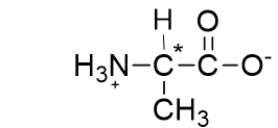
A) anomeric carbon.
B) alpha carbon.
C) beta carbon.
D) gamma carbon.
E) side-chain carbon.

A) anomeric carbon.
B) alpha carbon.
C) beta carbon.
D) gamma carbon.
E) side-chain carbon.

Unlock Deck
Unlock for access to all 134 flashcards in this deck.
Unlock Deck
k this deck
7
An amino acid zwitterion has
A) a net positive charge.
B) a net negative charge.
C) a net neutral charge.
D) any non-neutral charge.
E) Zwitterions can have any charge.
A) a net positive charge.
B) a net negative charge.
C) a net neutral charge.
D) any non-neutral charge.
E) Zwitterions can have any charge.

Unlock Deck
Unlock for access to all 134 flashcards in this deck.
Unlock Deck
k this deck
8
Which statement BEST describes the function of an enzyme in the body?
A) An enzyme acts as a buffer.
B) An enzyme transports waste out of the blood.
C) An enzyme signals cellular events.
D) An enzyme catalyzes chemical reactions.
E) All of the above describe the function.
A) An enzyme acts as a buffer.
B) An enzyme transports waste out of the blood.
C) An enzyme signals cellular events.
D) An enzyme catalyzes chemical reactions.
E) All of the above describe the function.

Unlock Deck
Unlock for access to all 134 flashcards in this deck.
Unlock Deck
k this deck
9
The following compound is a(n) 
A) amino acid.
B) dipeptide.
C) tripeptide.
D) polypeptide.
E) protein.

A) amino acid.
B) dipeptide.
C) tripeptide.
D) polypeptide.
E) protein.

Unlock Deck
Unlock for access to all 134 flashcards in this deck.
Unlock Deck
k this deck
10
A protein acts as a catalyst if its name ends with
A) -ase.
B) -ate.
C) -ine.
D) -ous.
E) -ite.
A) -ase.
B) -ate.
C) -ine.
D) -ous.
E) -ite.

Unlock Deck
Unlock for access to all 134 flashcards in this deck.
Unlock Deck
k this deck
11
An example of this type of protein is shown below. 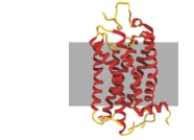
A) keratin
B) keratin, elastin, and collagen
C) membrane proteins and globular proteins
D) globular proteins
E) membrane proteins

A) keratin
B) keratin, elastin, and collagen
C) membrane proteins and globular proteins
D) globular proteins
E) membrane proteins

Unlock Deck
Unlock for access to all 134 flashcards in this deck.
Unlock Deck
k this deck
12
The following amino acid is classified as polar neutral.Which of the following statements best describes why it is classified this way? 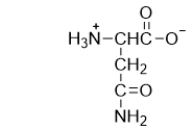 I.Its side chain is not ionizable. II.It buffers a solution at pH 7.
I.Its side chain is not ionizable. II.It buffers a solution at pH 7.
III)It is unreactive.
IV)Its side chain contains a polar functional group.
A) II only
B) III only
C) III and IV
D) I and IV
E) I and II
 I.Its side chain is not ionizable. II.It buffers a solution at pH 7.
I.Its side chain is not ionizable. II.It buffers a solution at pH 7.III)It is unreactive.
IV)Its side chain contains a polar functional group.
A) II only
B) III only
C) III and IV
D) I and IV
E) I and II

Unlock Deck
Unlock for access to all 134 flashcards in this deck.
Unlock Deck
k this deck
13
How is the following amino acid classified? 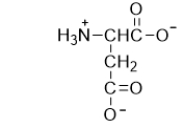
A) nonpolar
B) polar neutral
C) polar acidic
D) polar basic
E) None of the above is a correct classification.

A) nonpolar
B) polar neutral
C) polar acidic
D) polar basic
E) None of the above is a correct classification.

Unlock Deck
Unlock for access to all 134 flashcards in this deck.
Unlock Deck
k this deck
14
The following amino acid is classified as nonpolar.Which statement BEST describes why it is classified this way? 
A) It does not form a zwitterion.
B) It is neutral at physiological pH.
C) Its side chain is not charged at physiological pH.
D) Its side chain is a hydrocarbon.
E) This amino acid is soluble only in nonpolar solvents.

A) It does not form a zwitterion.
B) It is neutral at physiological pH.
C) Its side chain is not charged at physiological pH.
D) Its side chain is a hydrocarbon.
E) This amino acid is soluble only in nonpolar solvents.

Unlock Deck
Unlock for access to all 134 flashcards in this deck.
Unlock Deck
k this deck
15
During acidosis of a protein, shown below, salt bridges are broken, resulting in denaturation.Which choice shows the products of acidosis? 
A)
B)
C)
D)
E)

A)

B)

C)

D)

E)


Unlock Deck
Unlock for access to all 134 flashcards in this deck.
Unlock Deck
k this deck
16
Which of the following are methods of denaturing a protein?
A) pH changes
B) heating
C) mechanical agitation
D) detergents
E) All of the above are methods.
A) pH changes
B) heating
C) mechanical agitation
D) detergents
E) All of the above are methods.

Unlock Deck
Unlock for access to all 134 flashcards in this deck.
Unlock Deck
k this deck
17
Physiological pH is a pH of approximately
A) 5.7.
B) 7.4.
C) 8.1.
D) 9.1.
E) 0.
A) 5.7.
B) 7.4.
C) 8.1.
D) 9.1.
E) 0.

Unlock Deck
Unlock for access to all 134 flashcards in this deck.
Unlock Deck
k this deck
18
Hemoglobin contains iron.The iron is an example of a(n)
A) cofactor.
B) heme.
C) enzyme.
D) coenzyme.
E) metal.
A) cofactor.
B) heme.
C) enzyme.
D) coenzyme.
E) metal.

Unlock Deck
Unlock for access to all 134 flashcards in this deck.
Unlock Deck
k this deck
19
Sickle-cell anemia is caused by
A) an abnormal form of acetylcholine.
B) an abnormal form of iron.
C) too little iron.
D) an abnormal form of hemoglobin.
E) Actually, the cause of this disease is unknown.
A) an abnormal form of acetylcholine.
B) an abnormal form of iron.
C) too little iron.
D) an abnormal form of hemoglobin.
E) Actually, the cause of this disease is unknown.

Unlock Deck
Unlock for access to all 134 flashcards in this deck.
Unlock Deck
k this deck
20
The following is a description of an enzyme called superoxide dismutase.Refer to this paragraph to answer the following question. Superoxide dismutase is an enzyme that detoxifies a free radical called superoxide.This radical is responsible for causing injury during reperfusion after a heart attack, and is also thought to play a role in Parkinson's Disease.a Depending on what organism the protein is found in, it occurs either as a dimer or tetramer of identical subunits.b The subunits are mostly α-helical with some β-sheet near the C-terminus.c A metal binding site for manganese, iron, nickel or copper/zinc is composed of residues from both the N-terminus and the C-terminus.d These residues are: His-26, His-81, Asp-167, His-171.e
Which statement refers to a prosthetic group?
A) statement a
B) statement b
C) statement c
D) statement d
E) statement e
Which statement refers to a prosthetic group?
A) statement a
B) statement b
C) statement c
D) statement d
E) statement e

Unlock Deck
Unlock for access to all 134 flashcards in this deck.
Unlock Deck
k this deck
21
Which choice shows how an amino acid reacts in a low pH solution? 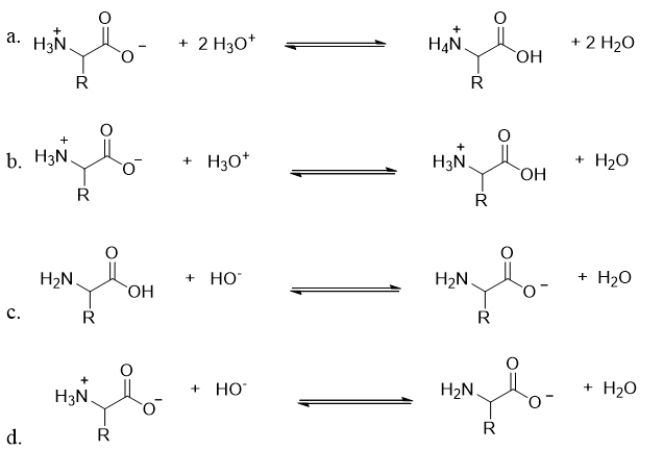
A) choice a
B) choice b
C) choice c
D) choice d
E) All of these reactions occur to the same extent in a solution with a pH less than 7.

A) choice a
B) choice b
C) choice c
D) choice d
E) All of these reactions occur to the same extent in a solution with a pH less than 7.

Unlock Deck
Unlock for access to all 134 flashcards in this deck.
Unlock Deck
k this deck
22
How is the following amino acid classified? 
A) nonpolar
B) polar neutral
C) polar acidic
D) polar basic
E) None of the above is a correct classification.

A) nonpolar
B) polar neutral
C) polar acidic
D) polar basic
E) None of the above is a correct classification.

Unlock Deck
Unlock for access to all 134 flashcards in this deck.
Unlock Deck
k this deck
23
This is the three-dimensional structure that occurs from electrostatic interaction between side chains.
A) primary structure
B) secondary structure
C) tertiary structure
D) quaternary structure
E) both secondary and tertiary structures
A) primary structure
B) secondary structure
C) tertiary structure
D) quaternary structure
E) both secondary and tertiary structures

Unlock Deck
Unlock for access to all 134 flashcards in this deck.
Unlock Deck
k this deck
24
A protein's primary structure is
A) its shape when it is first made.
B) its shape when it is not bound to a substrate.
C) its three-dimensional shape in which it is biologically active.
D) the shape of the protein without any cofactors.
E) its amino acid sequence.
A) its shape when it is first made.
B) its shape when it is not bound to a substrate.
C) its three-dimensional shape in which it is biologically active.
D) the shape of the protein without any cofactors.
E) its amino acid sequence.

Unlock Deck
Unlock for access to all 134 flashcards in this deck.
Unlock Deck
k this deck
25
What types of biomolecules are enzymes?
A) only proteins
B) only DNA molecules
C) proteins and some carbohydrates
D) proteins and some RNA molecules
E) carbohydrates and some RNA molecules
A) only proteins
B) only DNA molecules
C) proteins and some carbohydrates
D) proteins and some RNA molecules
E) carbohydrates and some RNA molecules

Unlock Deck
Unlock for access to all 134 flashcards in this deck.
Unlock Deck
k this deck
26
Which statement about noncompetitive inhibitors is FALSE?
A) Noncompetitive inhibitors are sometimes involved in feedback inhibition.
B) Noncompetitive inhibitors can serve a regulatory role in the body.
C) Noncompetitive inhibitors do not bind to the active site of an enzyme.
D) Increasing the concentration of a substrate restores function of an enzyme in the presence of a noncompetitive inhibitor.
E) Binding of a noncompetitive inhibitor results in deformation of an enzyme's active site.
A) Noncompetitive inhibitors are sometimes involved in feedback inhibition.
B) Noncompetitive inhibitors can serve a regulatory role in the body.
C) Noncompetitive inhibitors do not bind to the active site of an enzyme.
D) Increasing the concentration of a substrate restores function of an enzyme in the presence of a noncompetitive inhibitor.
E) Binding of a noncompetitive inhibitor results in deformation of an enzyme's active site.

Unlock Deck
Unlock for access to all 134 flashcards in this deck.
Unlock Deck
k this deck
27
Which of the following is the proper amino acid chain designator of the peptide below?  I.Val-Ser-Ala II.Ser-Ala-Val
I.Val-Ser-Ala II.Ser-Ala-Val
III)Ala-Ser-Val
A) All of these represent the same molecule.
B) I and III
C) I only
D) II only
E) III only
 I.Val-Ser-Ala II.Ser-Ala-Val
I.Val-Ser-Ala II.Ser-Ala-ValIII)Ala-Ser-Val
A) All of these represent the same molecule.
B) I and III
C) I only
D) II only
E) III only

Unlock Deck
Unlock for access to all 134 flashcards in this deck.
Unlock Deck
k this deck
28
What type of secondary structure is in blue in the following protein? 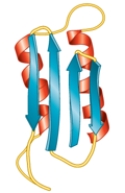
A) an α-helix
B) a parallel β-pleated sheet
C) an antiparallel β-pleated sheet
D) a random coil
E) This illustration does not show secondary structure.

A) an α-helix
B) a parallel β-pleated sheet
C) an antiparallel β-pleated sheet
D) a random coil
E) This illustration does not show secondary structure.

Unlock Deck
Unlock for access to all 134 flashcards in this deck.
Unlock Deck
k this deck
29
Which amino acid side chain is capable of hydrogen?
A) -CH3
B) -CH2OH
C) -COOH
D) -CH2CH2SCH3
E) All of the above are capable.
A) -CH3
B) -CH2OH
C) -COOH
D) -CH2CH2SCH3
E) All of the above are capable.

Unlock Deck
Unlock for access to all 134 flashcards in this deck.
Unlock Deck
k this deck
30
What type of interaction would you expect between the following -R groups in the tertiary structure of a protein? 
A) hydrogen bonds
B) hydrophobic interactions
C) peptide bonds
D) disulfide bonds
E) salt bridges

A) hydrogen bonds
B) hydrophobic interactions
C) peptide bonds
D) disulfide bonds
E) salt bridges

Unlock Deck
Unlock for access to all 134 flashcards in this deck.
Unlock Deck
k this deck
31
Which structure illustrates an amino acid at physiological pH? 
A) structure a
B) structure b
C) structure c
D) structure d
E) structure e

A) structure a
B) structure b
C) structure c
D) structure d
E) structure e

Unlock Deck
Unlock for access to all 134 flashcards in this deck.
Unlock Deck
k this deck
32
The following table lists several common vegetarian foods and the amino acids that they are missing.Which of the following combinations supply a complete protein when consumed together?
Food
Missing amino acid(s)
Beans
Methionine and tryptophan
Corn
Lysine and tryptophan
Peas
Methionine
Rice
Lysine
Walnuts
Lysine and tryptophan
Wheat
Lysine
A) wheat and corn
B) corn and beans
C) beans and peas
D) peas and corn
E) beans and walnuts
Food
Missing amino acid(s)
Beans
Methionine and tryptophan
Corn
Lysine and tryptophan
Peas
Methionine
Rice
Lysine
Walnuts
Lysine and tryptophan
Wheat
Lysine
A) wheat and corn
B) corn and beans
C) beans and peas
D) peas and corn
E) beans and walnuts

Unlock Deck
Unlock for access to all 134 flashcards in this deck.
Unlock Deck
k this deck
33
Which biomolecule has the MOST diverse functions in the body?
A) carbohydrates
B) proteins
C) nucleic acids
D) lipids
E) These have equally diverse functions.
A) carbohydrates
B) proteins
C) nucleic acids
D) lipids
E) These have equally diverse functions.

Unlock Deck
Unlock for access to all 134 flashcards in this deck.
Unlock Deck
k this deck
34
Enzymes are typically composed of this type of protein.
A) keratin
B) keratin, elastin, and collagen
C) membrane proteins and globular proteins
D) globular proteins
E) membrane proteins
A) keratin
B) keratin, elastin, and collagen
C) membrane proteins and globular proteins
D) globular proteins
E) membrane proteins

Unlock Deck
Unlock for access to all 134 flashcards in this deck.
Unlock Deck
k this deck
35
Which level of architecture is not affected by denaturation?
A) primary
B) secondary
C) tertiary
D) quaternary
E) All levels of architecture are affected by denaturation.
A) primary
B) secondary
C) tertiary
D) quaternary
E) All levels of architecture are affected by denaturation.

Unlock Deck
Unlock for access to all 134 flashcards in this deck.
Unlock Deck
k this deck
36
How does the potential energy of a correctly folded protein compare to the energy of an unfolded protein or an incorrectly folded one?
A) The energy of a correctly folded protein is lower.
B) The energy of a correctly folded protein is higher.
C) The energy of proteins is the same no matter how they are folded or unfolded.
D) Proteins do not have energy.
E) Sometimes the energy of a correctly folded protein is lower, and sometimes it is higher.
A) The energy of a correctly folded protein is lower.
B) The energy of a correctly folded protein is higher.
C) The energy of proteins is the same no matter how they are folded or unfolded.
D) Proteins do not have energy.
E) Sometimes the energy of a correctly folded protein is lower, and sometimes it is higher.

Unlock Deck
Unlock for access to all 134 flashcards in this deck.
Unlock Deck
k this deck
37
Is Gly-Ala-His the same tripeptide as His-Ala-Gly?
A) No, they are constitutional isomers.
B) No, they are stereoisomers.
C) Yes, they are conformers.
D) Yes, they are the same molecule, just flipped over.
E) Yes, the written order of amino acids does not make a difference in the peptide.
A) No, they are constitutional isomers.
B) No, they are stereoisomers.
C) Yes, they are conformers.
D) Yes, they are the same molecule, just flipped over.
E) Yes, the written order of amino acids does not make a difference in the peptide.

Unlock Deck
Unlock for access to all 134 flashcards in this deck.
Unlock Deck
k this deck
38
Which side chain would MOST likely be found in the interior of a protein, away from the aqueous environment?
A) -CH2OH
B) -CH2SH
C) -CH2COOH
D) -CH2CONH2
E)
A) -CH2OH
B) -CH2SH
C) -CH2COOH
D) -CH2CONH2
E)


Unlock Deck
Unlock for access to all 134 flashcards in this deck.
Unlock Deck
k this deck
39
These proteins are structural in nature.
A) keratin
B) keratin, elastin, and collagen
C) membrane proteins and globular proteins
D) globular proteins
E) membrane proteins
A) keratin
B) keratin, elastin, and collagen
C) membrane proteins and globular proteins
D) globular proteins
E) membrane proteins

Unlock Deck
Unlock for access to all 134 flashcards in this deck.
Unlock Deck
k this deck
40
Aspartic acid has a side chain that contains a carboxylic acid.At physiological pH, what is the structure of aspartic acid? 
A) structure a
B) structure b
C) structure c
D) structure d
E) structure e

A) structure a
B) structure b
C) structure c
D) structure d
E) structure e

Unlock Deck
Unlock for access to all 134 flashcards in this deck.
Unlock Deck
k this deck
41
According to the following graph, the activity of the enzyme decreases more sharply at high temperature than at low temperature.What are the reasons for this observation? 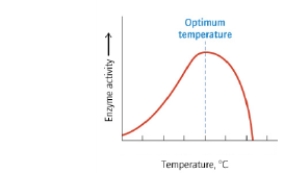 I.As temperature is increased, the substrate binding slowly becomes poorer. II.As temperature is decreased, the enzyme moves more slowly and so reacts more slowly.
I.As temperature is increased, the substrate binding slowly becomes poorer. II.As temperature is decreased, the enzyme moves more slowly and so reacts more slowly.
III)At higher temperatures, the enzyme is denatured and stops working entirely.
IV)Temperature has no effect on enzyme activity.
A) I only
B) IV only
C) I and III
D) II and III
E) All are correct.
 I.As temperature is increased, the substrate binding slowly becomes poorer. II.As temperature is decreased, the enzyme moves more slowly and so reacts more slowly.
I.As temperature is increased, the substrate binding slowly becomes poorer. II.As temperature is decreased, the enzyme moves more slowly and so reacts more slowly.III)At higher temperatures, the enzyme is denatured and stops working entirely.
IV)Temperature has no effect on enzyme activity.
A) I only
B) IV only
C) I and III
D) II and III
E) All are correct.

Unlock Deck
Unlock for access to all 134 flashcards in this deck.
Unlock Deck
k this deck
42
Which statement BEST describes how an enzyme lowers the activation energy of a reaction?
A) The enzyme covalently binds to the substrate, lowering its energy.
B) The enzyme chemically reacts with the substrate to make it more reactive.
C) The enzyme increases the temperature of the substrate, making it more reactive.
D) The substrate is held in the correct orientation for the reaction to occur.
E) All of the above describe how an enzyme lowers the activation energy.
A) The enzyme covalently binds to the substrate, lowering its energy.
B) The enzyme chemically reacts with the substrate to make it more reactive.
C) The enzyme increases the temperature of the substrate, making it more reactive.
D) The substrate is held in the correct orientation for the reaction to occur.
E) All of the above describe how an enzyme lowers the activation energy.

Unlock Deck
Unlock for access to all 134 flashcards in this deck.
Unlock Deck
k this deck
43
Tamoxifen is a drug used to prevent the recurrence of certain types of breast cancers that require estrogen to grow.Tamoxifen binds to the active site of the estrogen receptor protein, preventing estrogen from binding to the enzyme.Once Tamoxifen binds to the protein, the protein is permanently deactivated.Which descriptions BEST fits Tamoxifen?
A) Tamoxifen is an irreversible, noncompetitive inhibitor.
B) Tamoxifen is a reversible, noncompetitive inhibitor.
C) Tamoxifen is an irreversible, competitive inhibitor.
D) Tamoxifen is a reversible, competitive inhibitor.
E) Tamoxifen is not an inhibitor.
A) Tamoxifen is an irreversible, noncompetitive inhibitor.
B) Tamoxifen is a reversible, noncompetitive inhibitor.
C) Tamoxifen is an irreversible, competitive inhibitor.
D) Tamoxifen is a reversible, competitive inhibitor.
E) Tamoxifen is not an inhibitor.

Unlock Deck
Unlock for access to all 134 flashcards in this deck.
Unlock Deck
k this deck
44
According to the graph below, which of the following is TRUE? 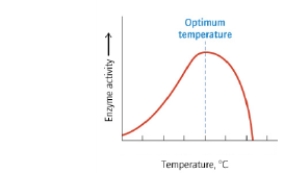
A) At high temperature, the activity of the enzyme decreases more sharply than it does at low temperature.
B) At low temperature, the activity of the enzyme decreases more sharply than it does at high temperature.
C) The maximum activity is at the lowest temperature.
D) The maximum activity is at the highest temperature.
E) The activity of the enzyme is the same at all temperatures.

A) At high temperature, the activity of the enzyme decreases more sharply than it does at low temperature.
B) At low temperature, the activity of the enzyme decreases more sharply than it does at high temperature.
C) The maximum activity is at the lowest temperature.
D) The maximum activity is at the highest temperature.
E) The activity of the enzyme is the same at all temperatures.

Unlock Deck
Unlock for access to all 134 flashcards in this deck.
Unlock Deck
k this deck
45
Hydrolysis of the peptide bonds in peptide below would result in 
A) no reaction.
B) a single amino acid.
C) two amino acids.
D) three amino acids.
E) four amino acids.

A) no reaction.
B) a single amino acid.
C) two amino acids.
D) three amino acids.
E) four amino acids.

Unlock Deck
Unlock for access to all 134 flashcards in this deck.
Unlock Deck
k this deck
46
What is the relationship between the following two molecules? 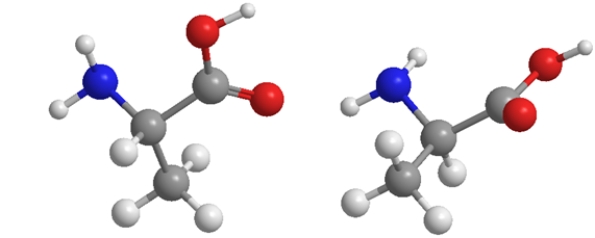
A) They are enantiomers.
B) They are identical.
C) They are conformers.
D) They are constitutional isomers.
E) They are unrelated.

A) They are enantiomers.
B) They are identical.
C) They are conformers.
D) They are constitutional isomers.
E) They are unrelated.

Unlock Deck
Unlock for access to all 134 flashcards in this deck.
Unlock Deck
k this deck
47
The structure of myoglobin is shown below.Which level of architecture does this protein lack? 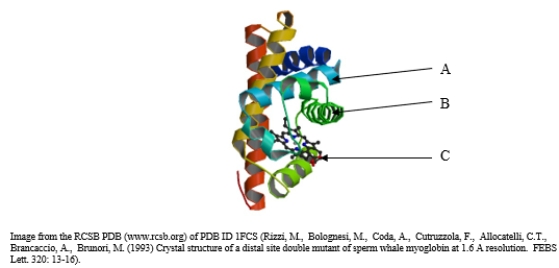
A) This protein has all levels of architecture.
B) primary
C) secondary
D) tertiary
E) quaternary

A) This protein has all levels of architecture.
B) primary
C) secondary
D) tertiary
E) quaternary

Unlock Deck
Unlock for access to all 134 flashcards in this deck.
Unlock Deck
k this deck
48
The following is a description of an enzyme called superoxide dismutase.Refer to this paragraph to answer the following question. Superoxide dismutase is an enzyme that detoxifies a free radical called superoxide.This radical is responsible for causing injury during reperfusion after a heart attack, and is also thought to play a role in Parkinson's Disease.a Depending on what organism the protein is found in, it occurs either as a dimer or tetramer of identical subunits.b The subunits are mostly α-helical with some β-sheet near the C-terminus.c A metal binding site for manganese, iron, nickel or copper/zinc is composed of residues from both the N-terminus and the C-terminus.d These residues are: His-26, His-81, Asp-167, His-171.e
Which statement refers to quaternary structure?
A) statement a
B) statement b
C) statement c
D) statement d
E) statement e
Which statement refers to quaternary structure?
A) statement a
B) statement b
C) statement c
D) statement d
E) statement e

Unlock Deck
Unlock for access to all 134 flashcards in this deck.
Unlock Deck
k this deck
49
What is the molecular shape of the carbon with the asterisk next to it? 
A) linear
B) bent
C) trigonal planar
D) tetrahedral
E) pyramidal

A) linear
B) bent
C) trigonal planar
D) tetrahedral
E) pyramidal

Unlock Deck
Unlock for access to all 134 flashcards in this deck.
Unlock Deck
k this deck
50
The amino acid sequence is the ________ of a protein.
A) primary structure
B) secondary structure
C) tertiary structure
D) quaternary structure
E) both secondary and tertiary structures
A) primary structure
B) secondary structure
C) tertiary structure
D) quaternary structure
E) both secondary and tertiary structures

Unlock Deck
Unlock for access to all 134 flashcards in this deck.
Unlock Deck
k this deck
51
Alpha-helices and β-pleated sheets are both examples of
A) primary structure.
B) secondary structure.
C) tertiary structure.
D) quaternary structure.
E) both secondary and tertiary structure.
A) primary structure.
B) secondary structure.
C) tertiary structure.
D) quaternary structure.
E) both secondary and tertiary structure.

Unlock Deck
Unlock for access to all 134 flashcards in this deck.
Unlock Deck
k this deck
52
Which choice has the BEST labels for this amino acid? 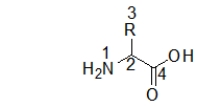
A) 1: amino acid 2: carbon 3: side chain 4: alcohol
B) 1: amide 2: α-carbon 3: R 4.ester
C) 1: amine 2: side chain 3: α-carbon 4.ester
D) 1: amide 2: α-carbon 3: side chain 4.carbonyl
E) 1: amine 2: α-carbon 3: side chain 4.carboxylic acid

A) 1: amino acid 2: carbon 3: side chain 4: alcohol
B) 1: amide 2: α-carbon 3: R 4.ester
C) 1: amine 2: side chain 3: α-carbon 4.ester
D) 1: amide 2: α-carbon 3: side chain 4.carbonyl
E) 1: amine 2: α-carbon 3: side chain 4.carboxylic acid

Unlock Deck
Unlock for access to all 134 flashcards in this deck.
Unlock Deck
k this deck
53
Which structure is the enantiomer of L-alanine? 
A) structure a
B) structure b
C) structure c
D) structure d
E) structure e

A) structure a
B) structure b
C) structure c
D) structure d
E) structure e

Unlock Deck
Unlock for access to all 134 flashcards in this deck.
Unlock Deck
k this deck
54
What is indicated by the arrow pointing to part of the Fischer projection below? 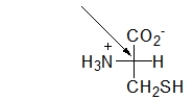
A) Nothing, this is just two molecules with their bonds crossed.
B) This is a carbon in the side chain of an amino acid.
C) This is the alpha carbon of an amino acid.
D) This is a carbon with a planar geometry.
E) This can be any type of atom.

A) Nothing, this is just two molecules with their bonds crossed.
B) This is a carbon in the side chain of an amino acid.
C) This is the alpha carbon of an amino acid.
D) This is a carbon with a planar geometry.
E) This can be any type of atom.

Unlock Deck
Unlock for access to all 134 flashcards in this deck.
Unlock Deck
k this deck
55
Which statement about fibrous proteins is TRUE?
A) Fibrous proteins are soluble in water.
B) Fibrous proteins usually contain both β sheets and α-helices.
C) Fibrous proteins are the most common structural protein in the body.
D) Fibrous proteins are always rigid.
E) Hemoglobin is an example of a fibrous protein.
A) Fibrous proteins are soluble in water.
B) Fibrous proteins usually contain both β sheets and α-helices.
C) Fibrous proteins are the most common structural protein in the body.
D) Fibrous proteins are always rigid.
E) Hemoglobin is an example of a fibrous protein.

Unlock Deck
Unlock for access to all 134 flashcards in this deck.
Unlock Deck
k this deck
56
Which of the following correctly shows the electrostatic interaction between amino acids that holds an α-helix or β-pleated sheet together?
A) -CH2S-SCH2-
B)
C)
D)
E) Any of these can act as the electrostatic interaction.
A) -CH2S-SCH2-
B)

C)

D)

E) Any of these can act as the electrostatic interaction.

Unlock Deck
Unlock for access to all 134 flashcards in this deck.
Unlock Deck
k this deck
57
Which of the amino acids does NOT contain a chiral carbon? 
A) amino acid a
B) amino acid b
C) amino acid c
D) amino acid d
E) amino acid e

A) amino acid a
B) amino acid b
C) amino acid c
D) amino acid d
E) amino acid e

Unlock Deck
Unlock for access to all 134 flashcards in this deck.
Unlock Deck
k this deck
58
Which statement about secondary structures is FALSE?
A) Some proteins only contain α-helices or β sheets.
B) Structural proteins often contain only β sheets.
C) Secondary structure is stabilized by hydrogen bonding between amides in the polypeptide backbone.
D) Side chains are involved in the hydrogen bonds that stabilize the secondary structure.
E) A protein can contain both α-helices and β sheets.
A) Some proteins only contain α-helices or β sheets.
B) Structural proteins often contain only β sheets.
C) Secondary structure is stabilized by hydrogen bonding between amides in the polypeptide backbone.
D) Side chains are involved in the hydrogen bonds that stabilize the secondary structure.
E) A protein can contain both α-helices and β sheets.

Unlock Deck
Unlock for access to all 134 flashcards in this deck.
Unlock Deck
k this deck
59
Which structure illustrates an amino acid as a zwitterion? 
A) structure a
B) structure b
C) structure c
D) structure d
E) structure e

A) structure a
B) structure b
C) structure c
D) structure d
E) structure e

Unlock Deck
Unlock for access to all 134 flashcards in this deck.
Unlock Deck
k this deck
60
Is the peptide shown below chiral? 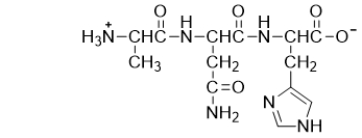
A) No, molecules with multiple chiral centers are not chiral.
B) Yes, it has chiral centers.
C) No, it has no chiral centers.
D) Yes, it has no chiral centers.
E) It is not possible to determine whether or not the peptide is chiral.

A) No, molecules with multiple chiral centers are not chiral.
B) Yes, it has chiral centers.
C) No, it has no chiral centers.
D) Yes, it has no chiral centers.
E) It is not possible to determine whether or not the peptide is chiral.

Unlock Deck
Unlock for access to all 134 flashcards in this deck.
Unlock Deck
k this deck
61
What kinds of interactions are NOT part of tertiary protein structure?
A) hydrophobic interactions
B) peptide bonds
C) hydrophilic interactions
D) salt bridges
E) disulfide bonds
A) hydrophobic interactions
B) peptide bonds
C) hydrophilic interactions
D) salt bridges
E) disulfide bonds

Unlock Deck
Unlock for access to all 134 flashcards in this deck.
Unlock Deck
k this deck
62
Which statement BEST defines an essential amino acid?
A) It is an amino acid that is necessary for life.
B) It is an amino acid that is synthesized in the body.
C) It is any of the 20 amino acids.
D) It is another name for the nonpolar amino acids.
E) It is an amino acid that cannot be produced by the body.
A) It is an amino acid that is necessary for life.
B) It is an amino acid that is synthesized in the body.
C) It is any of the 20 amino acids.
D) It is another name for the nonpolar amino acids.
E) It is an amino acid that cannot be produced by the body.

Unlock Deck
Unlock for access to all 134 flashcards in this deck.
Unlock Deck
k this deck
63
When several amino acids are connected together, head-to-tail, the resulting molecule is called a(n)__________.When more than 50 amino acids are connected together, the molecule is called a(n)___________.
A) enzyme; polypeptide
B) protein; polypeptide
C) polypeptide; protein
D) polypeptide; enzyme
E) nucleic acid; enzyme
A) enzyme; polypeptide
B) protein; polypeptide
C) polypeptide; protein
D) polypeptide; enzyme
E) nucleic acid; enzyme

Unlock Deck
Unlock for access to all 134 flashcards in this deck.
Unlock Deck
k this deck
64
The most common motifs for this level of structure are the helix and the β- pleated sheet.
A) primary structure
B) secondary structure
C) tertiary structure
D) quaternary structure
E) both secondary and tertiary structures
A) primary structure
B) secondary structure
C) tertiary structure
D) quaternary structure
E) both secondary and tertiary structures

Unlock Deck
Unlock for access to all 134 flashcards in this deck.
Unlock Deck
k this deck
65
Prion disease is a disease of the ________________ protein structure.
A) primary
B) secondary
C) tertiary
D) quaternary
E) Prion disease does not involve proteins.
A) primary
B) secondary
C) tertiary
D) quaternary
E) Prion disease does not involve proteins.

Unlock Deck
Unlock for access to all 134 flashcards in this deck.
Unlock Deck
k this deck
66
In the peptide Ser-Gly-Asp-Ala, the N-terminal amino acid is
A) aspartic acid.
B) alanine.
C) cysteine.
D) serine.
E) glycine.
A) aspartic acid.
B) alanine.
C) cysteine.
D) serine.
E) glycine.

Unlock Deck
Unlock for access to all 134 flashcards in this deck.
Unlock Deck
k this deck
67
Select the statement that BEST describes a key difference between competitive and noncompetitive inhibitors.
A) A competitive inhibitor binds to the active site, and a noncompetitive inhibitor does not.
B) A noncompetitive inhibitor binds to the active site, and a competitive inhibitor does not.
C) A competitive inhibitor is more effective than a noncompetitive inhibitor.
D) A noncompetitive inhibitor is more effective than a competitive inhibitor.
E) A noncompetitive inhibitor has structural similarities to the enzyme's active site, and the competitive inhibitor does not.
A) A competitive inhibitor binds to the active site, and a noncompetitive inhibitor does not.
B) A noncompetitive inhibitor binds to the active site, and a competitive inhibitor does not.
C) A competitive inhibitor is more effective than a noncompetitive inhibitor.
D) A noncompetitive inhibitor is more effective than a competitive inhibitor.
E) A noncompetitive inhibitor has structural similarities to the enzyme's active site, and the competitive inhibitor does not.

Unlock Deck
Unlock for access to all 134 flashcards in this deck.
Unlock Deck
k this deck
68
Which statement about enzyme names is FALSE?
A) Enzymes are often named after the type of reaction that they catalyze or their substrate.
B) Enzyme names almost always include the name of any cofactors involved in their reaction.
C) Enzyme names often have -ase at the end of them.
D) Some enzymes are named after where they were isolated from.
E) Enzyme names are typically italicized.
A) Enzymes are often named after the type of reaction that they catalyze or their substrate.
B) Enzyme names almost always include the name of any cofactors involved in their reaction.
C) Enzyme names often have -ase at the end of them.
D) Some enzymes are named after where they were isolated from.
E) Enzyme names are typically italicized.

Unlock Deck
Unlock for access to all 134 flashcards in this deck.
Unlock Deck
k this deck
69
How does your body know which proteins to make and in what order to place the amino acids when the proteins are synthesized?
A) The body does not make proteins; they are consumed in the diet.
B) There are special proteins in which this information is encoded.
C) Our DNA acts as a blueprint for proteins.
D) Our brain does this subconsciously.
E) The answer is not known to science.
A) The body does not make proteins; they are consumed in the diet.
B) There are special proteins in which this information is encoded.
C) Our DNA acts as a blueprint for proteins.
D) Our brain does this subconsciously.
E) The answer is not known to science.

Unlock Deck
Unlock for access to all 134 flashcards in this deck.
Unlock Deck
k this deck
70
The pH for optimum activity for most enzymes is
A) 5.4.
B) 7.4.
C) 8.0.
D) 9.0.
E) 10.4.
A) 5.4.
B) 7.4.
C) 8.0.
D) 9.0.
E) 10.4.

Unlock Deck
Unlock for access to all 134 flashcards in this deck.
Unlock Deck
k this deck
71
Which of the following is NOT common to all peptides?
A) the peptide backbone
B) amide functional groups
C) peptide bonds
D) repeating N Cα
Cα
 C=O units
C=O units
E) an alanine N-terminus
A) the peptide backbone
B) amide functional groups
C) peptide bonds
D) repeating N
 Cα
Cα C=O units
C=O unitsE) an alanine N-terminus

Unlock Deck
Unlock for access to all 134 flashcards in this deck.
Unlock Deck
k this deck
72
Which type of protein defends the body against infectious agents?
A) receptors
B) structural proteins
C) immunoglobulins
D) transport proteins
E) dietary proteins
A) receptors
B) structural proteins
C) immunoglobulins
D) transport proteins
E) dietary proteins

Unlock Deck
Unlock for access to all 134 flashcards in this deck.
Unlock Deck
k this deck
73
Not all proteins have this level of protein architecture.
A) primary structure
B) secondary structure
C) tertiary structure
D) quaternary structure
E) both secondary and tertiary structures
A) primary structure
B) secondary structure
C) tertiary structure
D) quaternary structure
E) both secondary and tertiary structures

Unlock Deck
Unlock for access to all 134 flashcards in this deck.
Unlock Deck
k this deck
74
Which of the following amino acids can form a disulfide bridge?
A) serine
B) alanine
C) cysteine
D) aspartic acid
E) lysine
A) serine
B) alanine
C) cysteine
D) aspartic acid
E) lysine

Unlock Deck
Unlock for access to all 134 flashcards in this deck.
Unlock Deck
k this deck
75
Which statement BEST describes the strategy used for treating hypertension through drug therapies?
A) to suppress how the body detects sodium
B) to suppress how the body detects low blood pressure
C) to lower blood pressure directly
D) to permanently disable renin
E) to inhibit the pathway that the body uses to increase blood pressure
A) to suppress how the body detects sodium
B) to suppress how the body detects low blood pressure
C) to lower blood pressure directly
D) to permanently disable renin
E) to inhibit the pathway that the body uses to increase blood pressure

Unlock Deck
Unlock for access to all 134 flashcards in this deck.
Unlock Deck
k this deck
76
At physiological pH, most carboxylic acids exist in their conjugate base form.Which structure illustrates the conjugate base of a carboxylic acid?
A) HCOOH
B) CH3COO+
C) HCOO+
D) HCOO-
E) CH3COOH2+
A) HCOOH
B) CH3COO+
C) HCOO+
D) HCOO-
E) CH3COOH2+

Unlock Deck
Unlock for access to all 134 flashcards in this deck.
Unlock Deck
k this deck
77
Which amino acid is polar neutral? 
A) amino acid a
B) amino acid b
C) amino acid c
D) amino acid d
E) amino acid e

A) amino acid a
B) amino acid b
C) amino acid c
D) amino acid d
E) amino acid e

Unlock Deck
Unlock for access to all 134 flashcards in this deck.
Unlock Deck
k this deck
78
The following is a description of an enzyme called superoxide dismutase.Refer to this paragraph to answer the following question. Superoxide dismutase is an enzyme that detoxifies a free radical called superoxide.This radical is responsible for causing injury during reperfusion after a heart attack, and is also thought to play a role in Parkinson's Disease.a Depending on what organism the protein is found in, it occurs either as a dimer or tetramer of identical subunits.b The subunits are mostly α-helical with some β-sheet near the C-terminus.c A metal binding site for manganese, iron, nickel or copper/zinc is composed of residues from both the N-terminus and the C-terminus.d These residues are: His-26, His-81, Asp-167, His-171.e
Which statement refers to primary structure?
A) statement a
B) statement b
C) statement c
D) statement d
E) statement e
Which statement refers to primary structure?
A) statement a
B) statement b
C) statement c
D) statement d
E) statement e

Unlock Deck
Unlock for access to all 134 flashcards in this deck.
Unlock Deck
k this deck
79
The boxed bond in the following peptide is a 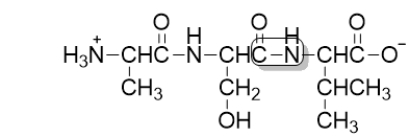
A) peptide bond.
B) ionic bond.
C) nonpolar covalent bond.
D) hydrogen bond.
E) chiral carbon.

A) peptide bond.
B) ionic bond.
C) nonpolar covalent bond.
D) hydrogen bond.
E) chiral carbon.

Unlock Deck
Unlock for access to all 134 flashcards in this deck.
Unlock Deck
k this deck
80
Which of the following is a complete protein?
A) meat
B) milk
C) eggs
D) soy
E) All of these are complete proteins.
A) meat
B) milk
C) eggs
D) soy
E) All of these are complete proteins.

Unlock Deck
Unlock for access to all 134 flashcards in this deck.
Unlock Deck
k this deck



